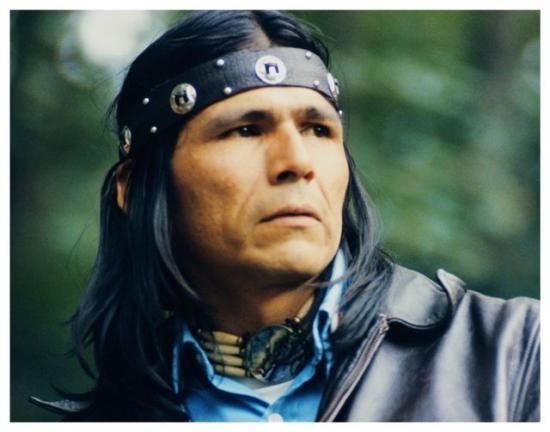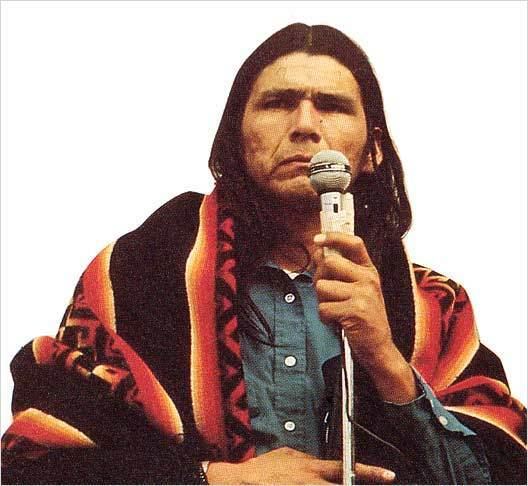Nationality American | Name Dennis Banks | |
 | ||
Movies The Last of the Mohicans, Older than America Children Danielle Louise Dickey, Janice Banks, Tiopa Banks Grandchildren Martina Day, Phillip Day, Cameron Day, Tayaira Day Similar People Russell Means, Clyde Bellecourt, Leonard Peltier, Anna Mae Aquash, Leonard Crow Dog | ||
Keynote address dennis banks
Dennis Banks (born April 12, 1937), a Native American leader, teacher, lecturer, activist and author, is an Anishinaabe born on Leech Lake Indian Reservation in northern Minnesota. Banks is also known as Nowa Cumig (Naawakamig in the Double Vowel System). His name in the Ojibwe language means "In the Center of the Universe." He has been a longtime leader of the American Indian Movement, which he co-founded in 1968 with Native Americans in Minneapolis.
Contents
- Keynote address dennis banks
- Native american leader dennis banks on overlooked tragedy of u s indian boarding schools
- Work with AIM
- Aquash murder and trial
- Education and career
- Politics
- Other activities
- Marriage and family
- Discography
- Filmography
- Autobiography
- References

Native american leader dennis banks on overlooked tragedy of u s indian boarding schools
Work with AIM

In 1968 Banks co-founded the American Indian Movement (AIM) in Minneapolis. They were seeking to ensure and protect the civil rights of Native Americans living in urban areas. According to Banks' autobiography, the impetus for forming the organization was the frequency of police raids on Indian bars. Minneapolis police would come into the bars, arrest every patron inside and use them for free labor over the weekend. Their related goals became to protect the traditional ways of Indian people and to engage in legal cases protecting treaty rights of Natives, such as hunting and fishing, trapping, and wild rice farming.

Banks participated in the 1969–1971 occupation of Alcatraz Island, initiated by Indian students from San Francisco of the Red Power movement, and intended to highlight Native American issues and promote Indian sovereignty on their own lands. In 1972 he assisted in the organization of AIM's "Trail of Broken Treaties", a caravan of numerous activist groups across the United States to Washington, D.C. to call attention to the plight of Native Americans. The caravan members anticipated meeting with United States Congress leaders about related issues; but government officials, most notably Harrison Loesch, the Interior Department Assistant Secretary responsible for the Bureau of Indian Affairs (BIA), refused to meet with delegates. The activists seized and occupied the headquarters of the Department of Interior and vandalized the offices of the BIA. Many valuable Indian land deeds were destroyed or lost during the occupation.

Banks went to Pine Ridge Indian Reservation in South Dakota in 1973 when the local civil rights organization asked for help in dealing with law enforcement authorities in nearby border towns. Residents of Pine Ridge believed the police had failed to prosecute the murder of a young Lakota man. Under Banks' leadership, AIM led a protest in Custer, South Dakota in 1973 against judicial proceeding that reduced the charges to a second degree offense against a white man accused of murdering a Native American.

AIM became involved in the political faction wanting to oust the elected chairman of the Oglala Sioux Tribe, Richard Wilson. A failure of an impeachment proceeding against him led to a large protest. Banks and other AIM activists led an armed takeover and occupation of Wounded Knee. After a siege of 71 days by federal armed law enforcement, which received national attention, the occupation was ended. A U.S. marshal was shot and paralyzed in March. A Cherokee and an Oglala Lakota were shot to death in April 1973, and civil rights activist Ray Robinson, who joined the protesters, disappeared during the occupation and is believed to have been murdered. Thirty resident families returned to the village to find that their homes and businesses had been looted and destroyed by the activists. The town was never rebuilt. Banks was the principal negotiator and leader of the Wounded Knee forces. Subsequent investigation of Wilson found questionable accounting practices, but no evidence of criminal offenses.

As a result of involvement in Custer and Wounded Knee, Banks and 300 others were arrested and faced trial. He was acquitted of the Wounded Knee charges, but was convicted of incitement to riot and assault stemming from the earlier confrontation at Custer.
Aquash murder and trial
Refusing the prison term, Banks went underground and organized a small armed AIM group. It included Anna Mae Pictou Aquash, considered the highest-ranking woman in AIM. About this time, the two were also involved in a personal relationship. After disappearing from Denver in late 1975, Aquash was found murdered in February 1976 at the Pine Ridge Reservation. She had been shot in the back of the head execution style, and her murder was unsolved for decades.
Banks was given amnesty in California by then Governor Jerry Brown, who refused to extradite him to South Dakota to face the charges related to activities in the 1973 Custer protests. He also received financial support from actor and AIM sympathizer Marlon Brando.
In January 2003 a federal grand jury indicted Arlo Looking Cloud and John Graham in the murder of Aquash. Since 2004 they have been convicted by federal and state juries; each is serving a life sentence. Witnesses at the 2004 trial of Arlo Looking Cloud included Kamook Nichols, Banks' former wife, who testified that she believed Aquash had been ordered killed by AIM leaders who feared she might be an informant. Aquash and Nichols had heard Leonard Peltier brag in 1975 about having shot two FBI agents to death earlier that year at Pine Ridge. Peltier was convicted of murdering the agents in 1977, and sentenced to two life terms. He remains imprisoned.
In 2008, Vine Richard "Dick" Marshall was indicted by a federal grand jury for aiding and abetting the murder of Aquash; he was alleged to have provided John Graham with a gun. He was acquitted of the charge. In 1975 he had been serving as one of Banks' bodyguards; Aquash was brought to his house on the Pine Ridge Reservation in December 1975 before being taken to the site of her murder. Authorities continue to investigate the Aquash murder.
Education and career
During his time in California from 1976 to 1983, Banks earned an associate's degree from the University of California, Davis. He taught at Deganawida Quetzecoatl University (DQU), a Native American-controlled institute of alternative higher learning, where he became the first American Indian chancellor. In 1978 he established the first spiritual run from Davis to Los Angeles, which is now an annual event. In the spring of 1979, he taught at Stanford University.
After Governor Brown left office, in 1984 Banks received sanctuary from the Onondaga Nation in upstate New York. While in New York, Banks organized the Great Jim Thorpe Longest Run from New York to Los Angeles; the goal was to restore the gold medals Thorpe had won at the 1912 Olympics to the Thorpe family.
In 1985 Banks left Onondaga to surrender to law enforcement officials in South Dakota. He served 18 months in prison related to the 1973 charges for the Custer riot. After his release, he worked as a drug and alcohol counselor on the Pine Ridge Indian Reservation. During 1987, grave robbers in Uniontown, Kentucky were halted in their digging for artifacts in American Indian grave sites. Banks organized the reburial ceremonies. His activities resulted in the states of Kentucky and Indiana passing strict legislation against grave desecration.
In 2006, Banks led Sacred Run 2006, a spiritual run from San Francisco's Alcatraz Island to Washington, D.C. The runners followed the ancient Native American tradition of bringing a message of "Land, Life and Peace" from village to village. They traveled around 100 miles every day and entered Washington, D.C. on Earth Day, April 22, 2006. Along the way, they took a southern route in solidarity with those who were rebuilding after hurricanes Katrina and Rita. Major events were held in Albuquerque, New Orleans, Philadelphia, Knoxville, and Washington, D.C.
Over the past 30 years since "The Longest Walk" in 1978, Sacred Runs have become an international movement. Sacred Run 2006 had runners from Japan, Australia, Ireland, and Canada, as well as many from the United States. International "The Longest Walk 2" followed in 2008 the Sacred Run 2006 route, as well as the original route of 1978 walk, ending with the "Manifesto for Change" delivered by Dennis Banks to Representative John Conyers.
Banks is a member of the Board of Trustees for Leech Lake Tribal College, a public, two-year college located just outside Cass Lake, Minnesota. He participates in governance of and fundraising for the college, which has a student body that is primarily Native American.
Politics
In August 2016, Banks received the vice presidential nomination of the Peace and Freedom Party, a socialist political party with ballot access in California. He appeared on the California ballot with presidential nominee Gloria La Riva.
Other activities
Banks has had roles in the movies War Party (1988), The Last of the Mohicans (1992), Thunderheart (1992), and Older Than America (2008).
The musical release Still Strong (1993) features Banks' original work as well as traditional Native American songs. He can also be heard on other albums: Peter Gabriel's Les Musiques du Monde and Peter Matthiessen's No Boundaries.
Marriage and family
According to birth records from Minnesota, Banks has seven children with wife Jeanette Banks: Janice Banks (born March 2, 1962), Darla Banks (born February 18, 1963), twins Deanna Jane and Dennis James Banks (born April 20, 1964), Red Elk Banks (born June 7, 1970), Tatanka Wanbli Banks (born September 7, 1971), and Minoh Bekwad Banks (born October 10, 1992).
At Pine Ridge Reservation, Banks met Darlene Kamook Nichols, who was 17 and still in high school. He was 32. After she graduated, they started seeing each other and married. They had three daughters and a son together: Tokala, Tiopa, Tasina and son Tacanunpa. They later divorced. (Kamook Nichols remarried and is now known as Darlene Ecoffey).
In Salt Lake City he had a daughter, named Arrow, with a Navajo girl named Angie Begay.
When Banks was in Japan, he married a woman named Machiko. After they had been together for two years, Machiko had a daughter, Michiko. Banks left Japan because he was fired by the Air Force, and he never saw Machiko or Michiko again. He returned to Japan several times, but Machiko had remarried and Michiko was at University in Northern Japan.
Banks has several stepchildren: Roland (Kawliga) Blanchard, Beverly Baribeau, Glenda Roberts, Denise Banks, Pearl Blanchard and Danielle Louise Dickey (she was murdered in 2007 on the Turtle Mountain Reservation in North Dakota). He has a granddaughter named Migizi Roberts from Minneapolis, Minnesota.
Discography
In 2012, Banks joined forces with Golden Globe and Grammy Award-winning artist Kitaro in celebration of the Earth on the CD Let Mother Earth Speak. The project contains a message of international peace intertwined with stories and life lessons from Banks featuring the music of Kitaro. The album was released on September 11, 2012, on Domo Records.
